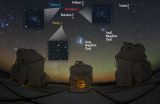(Press-News.org) A team of astronomers from the University of Cambridge have identified nine new dwarf satellites orbiting the Milky Way, the largest number ever discovered at once. The findings, from newly-released imaging data taken from the Dark Energy Survey, may help unravel the mysteries behind dark matter, the invisible substance holding galaxies together.
The new results also mark the first discovery of dwarf galaxies - small celestial objects that orbit larger galaxies - in a decade, after dozens were found in 2005 and 2006 in the skies above the northern hemisphere. The new satellites were found in the southern hemisphere near the Large and Small Magellanic Cloud, the largest and most well-known dwarf galaxies in the Milky Way's orbit.
The Cambridge findings are being jointly released today with the results of a separate survey by astronomers with the Dark Energy Survey, headquartered at the US Department of Energy's Fermi National Accelerator Laboratory. Both teams used the publicly available data taken during the first year of the Dark Energy Survey to carry out their analysis.
The newly discovered objects are a billion times dimmer than the Milky Way, and a million times less massive. The closest is about 95,000 light years away, while the most distant is more than a million light years away.
According to the Cambridge team, three of the discovered objects are definite dwarf galaxies, while others could be either dwarf galaxies or globular clusters - objects with similar visible properties to dwarf galaxies, but not held together with dark matter.
"The discovery of so many satellites in such a small area of the sky was completely unexpected," said Dr Sergey Koposov of Cambridge's Institute of Astronomy, the study's lead author. "I could not believe my eyes."
Dwarf galaxies are the smallest galaxy structures observed, the faintest of which contain just 5000 stars - the Milky Way, in contrast, contains hundreds of billions of stars. Standard cosmological models of the universe predict the existence of hundreds of dwarf galaxies in orbit around the Milky Way, but their dimness and small size makes them incredibly difficult to find, even in our own 'backyard'.
"The large dark matter content of Milky Way satellite galaxies makes this a significant result for both astronomy and physics," said Alex Drlica-Wagner of Fermilab, one of the leaders of the Dark Energy Survey analysis.
Since they contain up to 99 percent dark matter and just one percent observable matter, dwarf galaxies are ideal for testing whether existing dark matter models are correct. Dark matter - which makes up 25 percent of all matter and energy in our universe - is invisible, and only makes its presence known through its gravitational pull.
"Dwarf satellites are the final frontier for testing our theories of dark matter," said Dr Vasily Belokurov of the Institute of Astronomy, one of the study's co-authors. "We need to find them to determine whether our cosmological picture makes sense. Finding such a large group of satellites near the Magellanic Clouds was surprising, though, as earlier surveys of the southern sky found very little, so we were not expecting to stumble on such treasure."
The closest of these pieces of 'treasure' is 97,000 light years away, about halfway to the Magellanic Clouds, and is located in the constellation of Reticulum, or the Reticle. Due to the massive tidal forces of the Milky Way, it is in the process of being torn apart.
The most distant and most luminous of these objects is 1.2 million light years away in the constellation of Eridanus, or the River. It is right on the fringes of the Milky Way, and is about to get pulled in. According to the Cambridge team, it looks to have a small globular cluster of stars, which would make it the faintest galaxy to possess one.
"These results are very puzzling," said co-author Wyn Evans, also of the Institute of Astronomy. "Perhaps they were once satellites that orbited the Magellanic Clouds and have been thrown out by the interaction of the Small and Large Magellanic Cloud. Perhaps they were once part of a gigantic group of galaxies that - along with the Magellanic Clouds - are falling into our Milky Way galaxy."
INFORMATION:
The Dark Energy Survey is a five-year effort to photograph a large portion of the southern sky in unprecedented detail. Its primary tool is the Dark Energy Camera, which - at 570 megapixels - is the most powerful digital camera in the world, able to see galaxies up to eight billion light years from Earth. Built and tested at Fermilab, the camera is now mounted on the four-metre Victor M Blanco telescope at the Cerro Tololo Inter-American Observatory in the Andes Mountains in Chile. The camera includes five precisely shaped lenses, the largest nearly a yard across, designed and fabricated at University College London (UCL) and funded by the UK Science and Technology Facilities Council (STFC).
The Dark Energy Survey is supported by funding from the STFC, the US Department of Energy Office of Science; the National Science Foundation; funding agencies in Spain, Brazil, Germany and Switzerland; and the participating institutions.
The Cambridge research, funded by the European Research Council, will be published in The Astrophysical Journal.
One of the most important areas in all of biology is the evolution of photosynthesis. Some species of single celled cyanobacteria, through photosynthesis, forever changed the atmosphere of the early Earth by filling it with oxygen, allowing a huge expansion in terms of what life was possible on the planet.
Cardona et al., in the advanced online edition of Molecular Biology and Evolution, examined the evolution origins of the D1 protein in cyanobacteria, which forms the heart of Photosystem II, the oxygen-evolving machine of photosynthesis. Photosystem II's role is to ...
Researchers using the Karl G. Jansky Very Large Array (VLA) have produced the most detailed image yet of a fascinating region where clusters of hundreds of galaxies are colliding, creating a rich variety of mysterious phenomena visible only to radio telescopes.
The scientists took advantage of new VLA capabilities to make a "true color" radio image. This image shows the region as it would appear if human eyes were sensitive to radio waves instead of light waves. In this image, red shows where longer radio waves predominate, and blue shows where shorter radio waves predominate, ...
As sailors and mountaineers know very well, every knot carries out a specific function. There's a knot that slides, one that "floats", and one that comes undone with a single pull. In the field of nanotechnology as well, it is useful to have several kinds of molecular knots to be used, for instance, as mechanically resistant nano-cages for delivering chemical compounds or for confining and controlling toxic reagents. So far, molecular knots have only been produced by chemical synthesis, obtaining constructs on an atomic scale. In the study coordinated by SISSA professor ...
DENVER (March 10, 2015) - As branding and advertising creep into almost every facet of life, a new study from the University of Colorado Denver shows it's now making substantial inroads into popular music.
The study examined in detail the yearly top 30 Billboard songs from 1960 to 2013 - a total of 1,583 - and found a steep increase in `advertainment' or the use of product placement, branding and name dropping among the most popular music in the nation.
In 2006 alone, 20 of the top 30 songs, or two out of three, included at least one reference to a person, place or ...
Researchers at the Veterans Affairs San Diego Healthcare System and University of California, San Diego School of Medicine, with colleagues in New York and the United Kingdom, have identified genetic markers, derived from blood samples that are linked to post-traumatic stress disorder (PTSD). The markers are associated with gene networks that regulate innate immune function and interferon signaling.
The findings, published in the March 10 issue of the journal Molecular Psychiatry, offer novel insights into the pathophysiology of PTSD. In clinical terms, researchers say ...
Ithaca, NY--What inspires people to support conservation? As concerns grow about the sustainability of our modern society, this question becomes more important. A new study by researchers at Cornell University provides one simple answer: bird watching and hunting.
This survey of conservation activity among rural landowners in Upstate New York considered a range of possible predictors such as gender, age, education, political ideology, and beliefs about the environment. All other factors being equal, bird watchers are about five times as likely, and hunters about four ...
Philadelphia, PA, March 10, 2015 - In a study published in the Journal of the Academy of Nutrition and Dietetics, researchers from the RAND Corporation report that for people receiving food assistance there are significant links between depression, poor dietary quality, and high body mass index (BMI). They suggest that understanding the risk of depression among Supplemental Nutrition Assistance Program (SNAP) participants could be important to understanding the relationship among SNAP participation, diet, and weight.
"This study focuses on a group that is of particular ...
New evidence published today in the Cochrane Library shows that hormone replacement therapy does not protect post-menopausal women against cardiovascular disease, and may even cause an increased risk of stroke.
HRT, now more commonly known as hormone therapy, is widely used for controlling menopausal symptoms. It has also been used for the prevention of cardiovascular disease in post-menopausal women. This latest evidence looked at the effects of using hormone therapy for at least six months and involved more than 40,000 women across the world.
The length of time women ...
WASHINGTON, DC - March 10, 2015 - Households can serve as a reservoir for transmitting methicillin-resistant Staphylococcus aureus (MRSA), according to a study published this week in mBio®, the online open-access journal of the American Society for Microbiology. Once the bacteria enters a home, it can linger for years, spreading from person to person and evolving genetically to become unique to that household.
MRSA are strains of the bacterium Staphylococcus aureus that are resistant to almost all antibiotics related to penicillin, known as the beta-lactams. Since ...
Middle-aged Americans who show high levels of societal involvement and mental health are especially likely to construe their lives as stories of personal redemption, according to new research published in Psychological Science, a journal of the Association for Psychological Science.
Previous research has shown that adults who are inclined toward generativity - the concern for and commitment to promoting the growth and well-being of future generations - are more likely to engage in a wide range of prosocial behaviors, including positive parenting styles, political participation, ...

